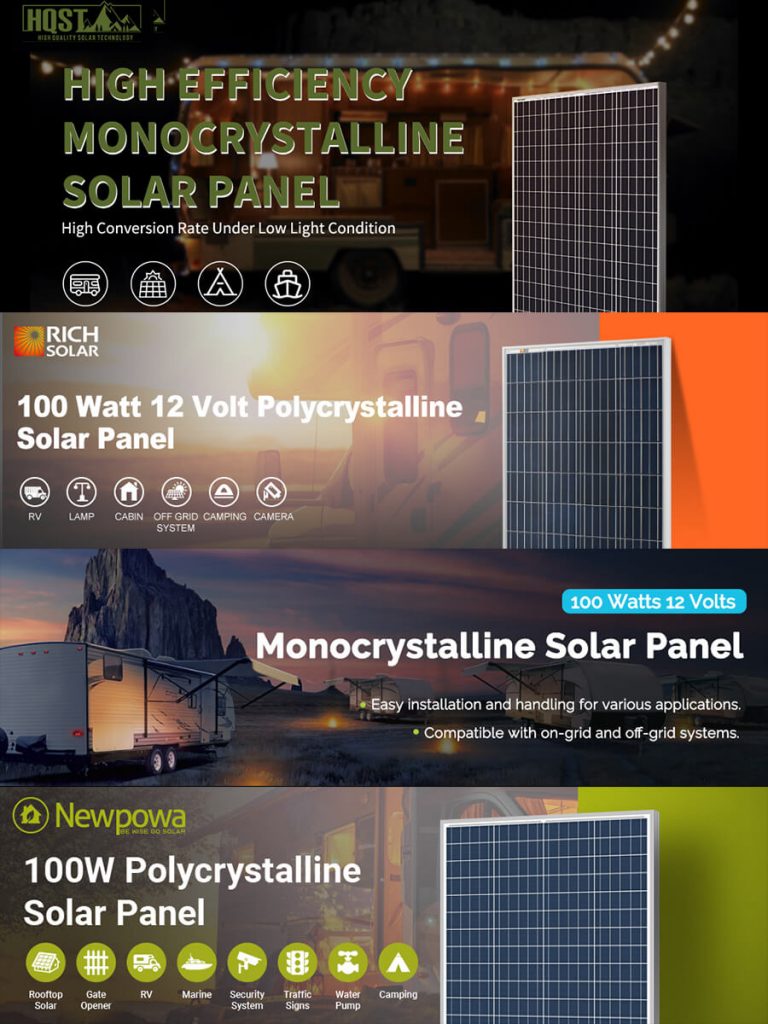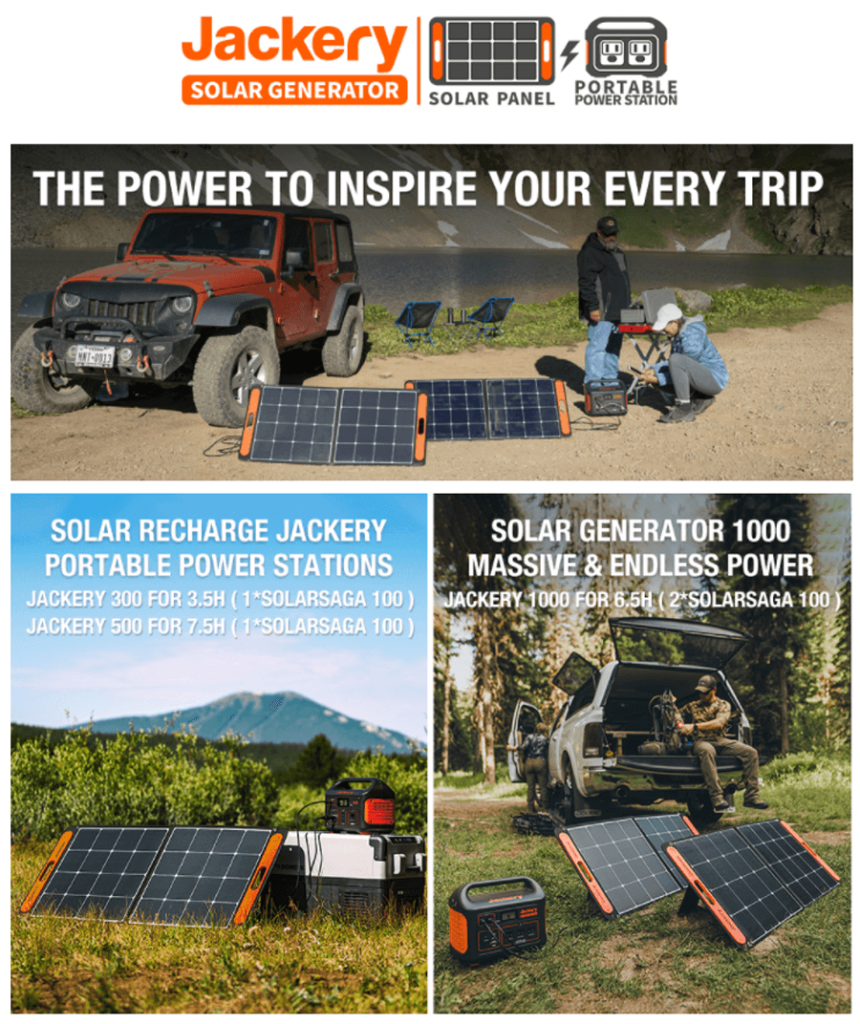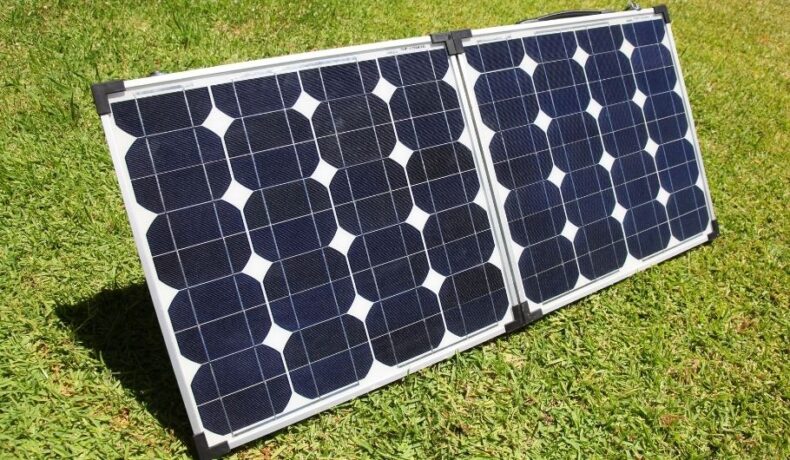A 100-watt solar panel is lightweight, has a small frame, and is easy to carry around, making it trendy for outdoor use like camping, chilling out in remote places, RV-ing, trekking, and more.
Along with it, you have the 400-watt solar panel, which is great for residential use, and the 500-watt panel, which is best for commercial use, to give you more electric sustenance.
Green energy consumers often use multiple 100-watt solar panels to store solar energy in what you call “portable power stations.”
To summarize, the 100-watt solar panel is best for the modern-day savvy explorer. It’s portable and goes best with a battery to power up your small to medium size devices. It is one of the best things to have when enjoying the adventures mother nature has to offer.
Table of Contents
What Is A 100-Watt Solar Panel Made Out Of?
If you had to go on to Amazon right now, most of the 100-watt solar panels are made out of monocrystalline solar cells with multi-layered sheet laminations that enhance cell performance and provide a long service life.
What Size Is A 100 Watt Solar Panel?
The dimensions of a 100-watt solar panel typically measure about 40 x 20 x 3 inches. Still, shorter ones have measurements of around 32.5 x 26.4 x 1.18 inches, making them easy to carry around.
How Much Power Does A 100-Watt Solar Panel Produce?
In an ideal situation, a 100-watt solar panel can produce 100 watts. The good news here is that, unlike your stationary roof panels, you have the ability to maximize how much power your 100-watt solar panel produces.
So how do you do this? By keeping in mind the ideal setup to maximize your solar power harvest.
Location
Let’s have a look at this solar map indicating areas you could go and enjoy abundant sources of irradiation.

If you are still confused about irradiation, it is simply the amount of solar power available per unit area, usually measured as watts per squared unit area.
Orientation And Tilt
Ideally, when placing your solar panels, you’d want them facing South, tilted at an angle between 30 to 40 degrees.
“Wait, I heard from somewhere that solar panels work at higher altitudes. Is this true?“
Yes, your 100-watt solar panel will receive more irradiation at higher altitudes. Up to 42% increased efficiency based on a study we found. It will provide you with more electricity and charge your batteries faster.
A word of caution, though. Make sure you bring sun protection and your sensitive equipment when doing this.
You will indeed get more juice at greater heights. But it also means that you will be exposed to the sun as well. There is also the risk of overheating your solar panels and electric devices.
You can get the most power out of your 100-watt solar panel if you lay it in a high place abundant in solar irradiation. Make sure to have it facing South and experiment with different tilt angles. We recommend you try different tilts in multiples of 15 degrees.
How Much Energy Does A 100W Solar Panel Produce?
The amount of energy a 100-watt solar panel produces largely depends on its power at a given time. Remember, the relationship between power and energy is that energy is the capacity to do work, and power is the time rate of doing work. Energy is expressed in watt-hours, while power is measured in watts.
Now, let’s complement this concept with an analogy that cyclists will love.
Imagine a professional cyclist sprinting towards the finish line in a Tour de France race.
During this final sprint, his legs produce 1600 peak watts for a couple of seconds, which is his maximum power output. Then, after he crosses the finish line, he slowly ramps down and maintains his power output to 200 watts.
The amount of energy he expended between his final sprint and after passing the finish line highly depends on the power being produced by his legs at each given moment.
Okay, now that we know how power and energy differ, let’s determine how much energy a 100-watt solar panel produces.
You can get your 100-watt solar panel’s solar energy when you multiply its power output by the equivalent peak sun hours it gets.
Now, let’s see how much energy a 100w solar panel produces through an example.
If you live in Florida, your 100-watt solar panel receives, on average, about 4.9 hours of peak sun hours daily. Applying the formula we mentioned, you will get about 490 Watt-hours of solar energy daily.
What Can I Power With A 100-Watt Solar Panel?
Now, what can you power with a 100-watt solar panel?
Like we said in the beginning, this solar panel is most helpful in powering smaller devices like cell phones, LED lights, laptops, fans, and the like.
To give you a better answer, let’s reverse the question: What can you NOT power with a 100 Watt Solar Panel? Think microwave, coffeemaker, toaster, fridge, your heat pump, and dishwasher.
If you are still unsure whether you can power a device with your 100-watt solar panel, take a look at the nameplate of your appliance that looks like the image below.
We specifically picked this coffee brewer nameplate to demonstrate the difference between watts (W) and kilowatts (kW). Both are power units, but a kilowatt equals a thousand watts.

Therefore, in our example, the appliance power requirements range between 4.6-9.1 kW, which means 4,600 watts up to 9,100 watts.
This exaggerated example means that you’ll need ninety-one 100-watt solar panels to power up this monstrosity. Yikes!
100 watt solar panels are best for small devices such as phones, tablets, laptops, and other compact electronics. As a bonus tip, if you use your solar panel to power these sensitive gadgets, we recommend getting a good-quality inverter to make them last longer.
To our fellow geeks out there, we are talking about getting inverters with low harmonics. IEEE Standard 519, anyone? Just us? Okay then.
How Many Batteries Do I Need For A 100W Solar Panel?
Well, it depends. How long do you want to use solar energy alone?
Instead of dictating a fixed value, let’s try to add a nugget of knowledge to your green energy utility belt today.
If you’re in a hurry, our quick answer is getting a battery that can store a day’s worth of your needs.
For example, suppose you are looking to power a 25-watt phone. In that case, we recommend something like a Jackery Portable Power Station Explorer 240, 240Wh Backup Lithium Battery.
This battery can provide you with about ten hours of cellphone usage.
Pop quiz: Figure out how we got to about ten hours’ worth of power for your phone. Got it? Good.
Know What The Batteries Are For
Knowing how many batteries you need for a 100w solar panel depends on the application. The good news is that sizing a battery based on your needs is not that hard with a little bit of help from your C-Biz friends.
Know your peak power requirements. What are the devices you picked? Is it a laptop and a cellphone? That’s about 100 and 25 watts, respectively, giving you 125 peak watts in total. This is the maximum power output you need for your battery.
Sizing Your Battery Needs
Estimate your energy demand. Now, after you determine the total power rating of the devices, you will connect them to your battery. Ask the question: for how long?
Using our 240Wh Jackery example, you can power up your laptop and cell phone for about two hours. However, we don’t recommend going outside the 30-80% charge time to prolong the life of your battery.
Know how many batteries you need. Some of you might want to run that laptop and cellphone for 8 hours. If that is the case, we recommend buying four Jackery portable power stations. But there are more considerable battery size variations, like the Jackery Portable Power Station Explorer 1000. Explore your options!
So, there you have it! A simple 2-step process to know how many batteries you need for a 100-watt solar panel.
In summary, you have to know your power requirements based on what you want to power, then discern how long you want to keep them running on solar alone. Lastly, see what is available to accommodate your power and energy needs.
Which Companies Produce 100W Solar Panels?
- HQST
- Renogy
- Newpowa
- Rich Solar
We also found some flashy foldable solar panels, but some of these are precisely made to power up their specific portable power station counterparts. Here are the top brands we found:
- Jackery
- Topsolar
- Rockpals
- Eco-worthy
- Bluetti
How Much Do 100-Watt Solar Panels Cost?
A traditional 100-watt solar panel will cost around $78 to $93 per solar panel.
How about the flashy, foldable ones? A quick search will give you a range between $120 to $300.
5 Of The Best 100-Watt Solar Panels You Can Buy

After comparing all the brands we could find, here are the best options based on customer reviews, features, and brand reputation:
| Specifications | HQ | Renogy | Rich Solar | Newpowa |
| Size | 32.52 x 1.18 x 26.38 inches | 42.4 x 20 x 1.38 inches | 39.6 x 26.4x 1.4 inches | 35.83*26.57*1.18 inches |
| Weight | 14.82 pounds | 14.3 pounds | 17.5 lbs | 15.43 lbs |
| Material | Monocrystalline | Monocrystalline | Polycrystalline | Polycrystalline |
| Optimum Operating Voltage (Vmp) / Current (Imp) | 18.0V / 5.56A | 18.6V / 5.38A | 18.5V / 5.41 | 17.0V / 5.89A |
| Cost | $89.99 | $93.91 | $89.99 | $83.50 |
| Warranty | 3-year warranty | 25-year transferable power output; 5-year material and workmanship | 25-year transferable power output; 5-year material and workmanship | 25-year transferable power output warranty |
These four products are typically used for RVs or stored in pickups during road trips.
Foldable-Type Solar Panels

We decided to introduce a foldable 100-watt solar to give you more variety for the fifth one. This type is a bit pricier but offers more portability and is claimed to be more efficient.
The Jackery SolarSaga 100W Portable Solar Panel is made to charge a portable power station. Aside from being foldable, it outperforms other conventional panels in its weight and size category. It weighs 5.5 pounds and has a product dimension of 22.83 x 19.69 x 2.36 inches.
At this point, some of you may already think this is a hard sell, but it isn’t. We want to thoroughly deliver on our promise and introduce you to other possibilities within the realm of 100-watt solar panels.
If you value portability and are willing to pay twice or thrice the price of a traditional 100-watt solar panel, then this is your product.
However, remember that these foldable panels are often made only to charge portable power stations. They are not for full-on DIY solar system setups.
Using Conventional Panels To Charge Portable Power Stations
Now, some of you might be wondering if it’s possible to charge a Jackery Explorer Portable Power Station with a conventional 100-watt solar panel.
Although unconventional, it is possible to attach the traditional 100W solar panels to the Jackery Explorer. However, you need an MC4 to 8mm with a positive female adapter to do this.
You’ll also need to do some calculations to ensure that the current outputs of parallel-connected solar panels fall within the specs of the sample Jackery battery.
Bottom line: 100-watt solar panels can either be for off-grid systems or tethered explicitly to a portable power station. The foldable panels are twice or thrice as expensive as the conventional ones but offer more portability and efficiency.
Lastly, as a bonus, here is a good YouTube product review for the four conventional panels we selected.
What Are The Best Applications For A 100 Watt Solar Panel?
The strength of 100-watt solar panels lies in their portability. We can think of various applications that capitalize on their advantage over their bulky counterparts.
First, it is an excellent choice for outdoor activities.
Second, it is also a candidate for DIY solar enthusiasts who want to start small. The small frame and light weight of the 100-watt solar panel give you more maneuverability when installing it on the roof.
It is comparable to the 400W and 500W when it comes to $ per watt, but it comes with a more negligible risk in terms of capital cost. The best eggs to break to make your perfect solar system omelet.
Here are the typical prices per solar panel size
100 Watts – $78 to $93
How To Maintain Your 100W Solar Panel?
Learning how to maintain your 100-watt solar panel isn’t that difficult.
Unlike the bulkier ones, where you need a makeshift roof rake and a mop converter, 100-watt solar panels offer you maneuverability, making cleaning easier.
Now, here is the minimum requirement when maintaining your 100-watt solar panel: Make sure they aren’t covered by snow during the winter. Then, ensure you wash them now and then. Once a year is usually fine.
We have an article where we discuss this topic at length.
Of course, the best way to monitor if you are doing enough maintenance on your solar panels is to monitor their performance.
You can achieve this by integrating a solar panel monitoring system into your setup.
You can track how much energy your panels produce on any given day and how much they produce over time. If you buy a good one, your monitoring system could even notify you if a panel is out of commission for whatever reason.
From here, you can determine how various external factors affect your panels’ performance and how well they maintain their efficiency across their lives.
Solar panels are designed to be durable, but there will be times when they cannot withstand extreme weather conditions. This might affect their performance in the long run. However, it shouldn’t worry you too much.
The change in performance is usually covered in your solar panel warranty, so read the fine print.
The best solar companies will give you a warranty of between 15 and 25 years and guarantee that your panels’ energy production remains at 85% or above for that entire time.
Final Thoughts
100-watt solar panels are perfect for people who are trying to dip their toes in the water. They are affordable and an excellent choice for both entry-level green energy enthusiasts learning how to build DIY solar generators and adventurers who want power on the go.
100-watt solar panels are ideal for small and medium gadgets and can be coupled with a portable power station to store solar energy.

